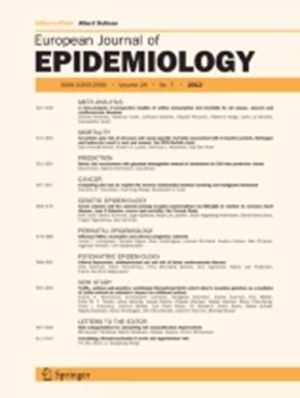Associations of alcohol drinking with incident dementia: a prospective study from the UK Biobank.
IF 5.9
1区 医学
Q1 PUBLIC, ENVIRONMENTAL & OCCUPATIONAL HEALTH
引用次数: 0
Abstract
Relationship between alcohol drinking and incident dementia remained uncertain. This study used UK Biobank cohort data to investigate the association between alcohol drinking and dementia risk, and potential effect modifications by cardiovascular disease (CVD) risk, APOE4 gene, and sex. We excluded infrequent drinkers and participants with baseline dementia or dementia within two years of follow-up. Drinking status was defined as non-drinking, low-moderate and heavy drinking (by weekly alcohol units). Drinking behaviors included drinking with meals and drinking type. Primary outcome was all-cause dementia. Hazard ratios (HRs) and 95% confidence intervals (CIs) were estimated by multivariable Cox regression models. Subgroup analyses stratified by CVD risk, APOE4 gene, and sex were conducted. Among 296,715 participants (mean age 56.54 years), 4,242 developed dementia over a median follow-up of 13.7 years. Compared to non-drinking, low-moderate drinking reduced dementia risk (HR, 0.65; 95% CI, 0.59-0.73), while heavy drinking showed no significant association (HR, 0.88; 95% CI, 0.75-1.02). All drinking behaviors lowered dementia risk. Low-moderate drinking reduced dementia risk across subgroups: high/low CVD risk (HR 0.66, 95% CI 0.59-0.74/0.43, 0.30-0.61), APOE4 carriers/non-carriers (HR 0.71, 0.61-0.83/0.61, 0.52-0.71), females/males (HR 0.67, 0.58-0.77/0.63, 0.53-0.76). Compared with non-drinking, low-moderate drinking is associated with lower incident dementia risk, regardless of CVD risk, APOE4 gene, and sex. The protective effect of alcohol drinking was consistent among various drinking behaviors. Thus, this study confirmed the protective effect of low-moderate drinking in population, and provided insights for improving alcohol-related public health guidelines for dementia prevention.饮酒与痴呆的关系:一项来自英国生物银行的前瞻性研究
饮酒与痴呆之间的关系仍不确定。本研究使用英国生物银行队列数据来调查饮酒与痴呆风险之间的关系,以及心血管疾病(CVD)风险、APOE4基因和性别对其潜在影响的改变。我们排除了不经常饮酒者和基线痴呆或随访两年内痴呆的参与者。饮酒状态被定义为不饮酒、低、中度和重度饮酒(按每周饮酒单位)。饮酒行为包括随餐饮酒和饮酒类型。主要结局是全因痴呆。采用多变量Cox回归模型估计风险比(hr)和95%置信区间(ci)。按心血管疾病风险、APOE4基因和性别分层进行亚组分析。在296,715名参与者(平均年龄56.54岁)中,有4,242人在13.7年的中位随访期间患上了痴呆症。与不饮酒相比,低、中度饮酒可降低痴呆风险(HR, 0.65; 95% CI, 0.59-0.73),而重度饮酒无显著相关性(HR, 0.88; 95% CI, 0.75-1.02)。所有的饮酒行为都能降低患痴呆症的风险。低-中度饮酒降低痴呆风险:高/低心血管疾病风险(HR 0.66, 95% CI 0.59-0.74/0.43, 0.30-0.61), APOE4携带者/非携带者(HR 0.71, 0.61-0.83/0.61, 0.52-0.71),女性/男性(HR 0.67, 0.58-0.77/0.63, 0.53-0.76)。与不饮酒相比,无论心血管疾病风险、APOE4基因和性别如何,低-中度饮酒与较低的痴呆发生风险相关。饮酒的保护作用在不同的饮酒行为中是一致的。因此,本研究证实了人群中低水平饮酒的保护作用,并为改善与酒精相关的痴呆症预防公共卫生指南提供了见解。
本文章由计算机程序翻译,如有差异,请以英文原文为准。
求助全文
约1分钟内获得全文
求助全文
来源期刊

European Journal of Epidemiology
医学-公共卫生、环境卫生与职业卫生
CiteScore
21.40
自引率
1.50%
发文量
109
审稿时长
6-12 weeks
期刊介绍:
The European Journal of Epidemiology, established in 1985, is a peer-reviewed publication that provides a platform for discussions on epidemiology in its broadest sense. It covers various aspects of epidemiologic research and statistical methods. The journal facilitates communication between researchers, educators, and practitioners in epidemiology, including those in clinical and community medicine. Contributions from diverse fields such as public health, preventive medicine, clinical medicine, health economics, and computational biology and data science, in relation to health and disease, are encouraged. While accepting submissions from all over the world, the journal particularly emphasizes European topics relevant to epidemiology. The published articles consist of empirical research findings, developments in methodology, and opinion pieces.
 求助内容:
求助内容: 应助结果提醒方式:
应助结果提醒方式:


